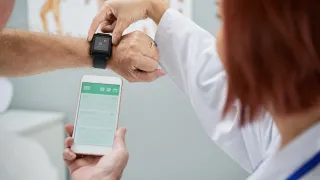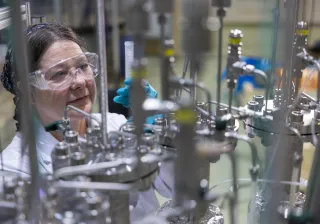The population is ageing and healthcare costs are growing. Healthcare is also undergoing a digital transition, which Simon Kos, Chief Medical Officer and Senior Director at IT giant Microsoft, says will improve the quality and lower the costs of healthcare.
Simon Kos, who has a medical degree, is in charge of Microsoft's health technology strategy. He believes that AI-based technology will soon break into the healthcare sector, so long as the medical profession sets aside its prejudices about the new technologies set to revolutionise healthcare practices, and as evidence gathers of how such technologies improve patient safety.
Improving patient safety is a key objective of the health sector: help is being sought from smart technologies. In the United States, for example, the third largest cause of death is treatment errors, despite the development of digital solutions in the healthcare sector.
– As an intensive care physician, I saw with my own eyes how communication between care staff breaks down during critical emergency care if it is unsupported by digital processes. This led to my desire to use technology to improve health care.
Kos explains that data can be used in a number of ways to improve human wellbeing.
For example, the impact of the recent rapid digitalisation of consumer markets can be seen in the development of various technologies for enhancing home comfort and continuous demand for more such innovations. People are discussing smart living – about smart homes in which, for example, carbon dioxide sensors and air volume regulators sense internal air, and the system adjusts the ventilation. Kos believes that, as technology prices fall, developments of this kind will gather pace on the consumer market.
AI and the related technologies will also be seen more often in patient care in clinics and hospitals.
– Medicine is living through very interesting times, due to the dizzying pace of technological progress. However, the sector is not very open to changes and there is resistance to new treatment practices and technologies, Kos admits.
Artificial intelligence to help doctors
According to Kos, AI's ability to control large data masses makes it an effective weapon in the fight against medical errors. But doctors will continue to be needed in the future.
– People and machines complement each other in patient care: for example, people have insight and emotional intelligence, while machines are effective at handling large volumes of repetitive tasks where precision is vital.
Although smart technologies are just becoming a permanent part of daily patient care, Kos points out that positive examples can already be seen. For instance, the US Ochsner Clinic has just introduced an artificial intelligence system that enables the monitoring of the patient's condition and thereby improvements in patient safety.
– The system helps to make a complex prognosis on a patient's condition and assists doctors in identifying patients at high risk of cardiac arrest, for example.
According to Kos, the amount of medical data currently available is so enormous that its analysis would be impossible without advanced information technology.
– We can achieve the best possible treatment outcome through cooperation between people and technology.
Virtual doctor on site
Technology can also help to improve wellbeing by offering alternatives to expensive hospital care. For example, in Perth, Australia, the Silver Chain in-home care service brings healthcare services to the patient's home. If a home-care patient needs specialised medical services, the nurse visiting the patient puts on Microsoft HoloLens mixed reality smart glasses and begins remote consultation with a doctor. If the patient also wears smart glasses, it is as if the doctor were a three-dimensional, real figure sitting in the room.
According to Kos, remote care services of this kind will accelerate access to treatment, particularly where there are long distances between home and hospital. It will also help to avoid the risks associated with hospitals, where there are many sick people and ailing patients are at high risk of infection.
Global eradication of epidemics
In the longer term, Kos estimates that technology can help halt, or even prevent, disease outbreaks. New infectious diseases, such as Zika, Ebola and chikungnya, are dangerous to public health and unpredictable. To halt these diseases, very early information is required on the progress of the pathogens that cause them.
In the Project Premonition study, Microsoft researchers are using drones to transport mosquito traps. By analysing the content of the traps, they are seeking to identify and combat the spread of viruses that cause serious infectious diseases. The Microsoft researchers' ultimate goal is to identify epidemics before the diseases enter the human population.
– They estimate that 60-75% of new infectious diseases originate in animals, which are very difficult to monitor. Analysing DNA from mosquito samples will help determine, among other things, which animal the mosquito has bitten and the possible pathogens transferred to the animal's bloodstream.




